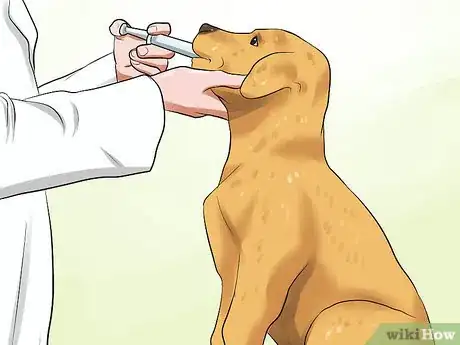This article was co-authored by Pippa Elliott, MRCVS. Dr. Elliott, BVMS, MRCVS is a veterinarian with over 30 years of experience in veterinary surgery and companion animal practice. She graduated from the University of Glasgow in 1987 with a degree in veterinary medicine and surgery. She has worked at the same animal clinic in her hometown for over 20 years.
There are 8 references cited in this article, which can be found at the bottom of the page.
This article has been viewed 162,758 times.
Due to fears of rabies and other animal diseases, the UK has some of the strictest pet quarantine laws in the world. If you are shipping a pet to the UK, you will need to get the necessary tests and treatments for your pet, obtain the necessary documentation, and find a reputable transport company. Thanks to the UK Pet Travel Scheme (PETS), your pet will not need to fulfill a six month quarantine period as long as you have fulfilled these requirements.[1]
Steps
Getting the Necessary Tests and Vaccines
-
1Make sure your pet is fitted with a microchip. If you are shipping a dog, a cat, or a ferret to the UK, your pet should be fitted with a microchip by your vet. This microchip will ensure your pet is properly identified when he reaches the UK.
- Keep in mind microchips do not act as GPS devices or tracking devices for your pet. Instead, they contain a radio-frequency identification that acts as a permanent ID for your pet. The microchip procedure is painless for your pet and can be done at your vet’s office.[2]
- Not all microchips use the same reader. To ensure the chip can be read, you can purchase one that is compatible with the chip, or you can ask your vet what type of chip has been implanted and then contact the UK DEFRA organization to see if the readers are compatible. If the chip cannot be read, you pet will likely be put into quarantine.
-
2Get your pet vaccinated for rabies. This is a required step in the process of bringing your pet to the UK. You will need to have your pet vaccinated for rabies even if he has a current rabies vaccination.[3] Make sure this information is recorded in your pet's passport on on their health certificate.
- Once your vet gives your pet the rabies vaccine, you will need to wait 21 days from the day after your pet received the vaccine to make arrangements for your pet to enter the UK.
Advertisement -
3Have your dog tested and treated for tapeworm. If your pet is a dog and you are planning to have him shipped to the UK, you will need to have him treated with an approved product containing praziquantel, which is effective at killing the tapeworms (Echinococcus multilocularis).[4]
- The treatment must be approved for use in the country in which it’s being given.
- If your dog has tapeworm, your veterinarian should apply the treatment for tapeworm no more than five days before your pet is scheduled to be shipped to the UK, and the treatment should be recorded on your pet’s health certificate to show he has been treated for tapeworm.
Obtaining the Necessary Documentation
-
1Get a health certificate for your pet. Your vet can provide you with a copy of your pet’s health certificate stating the pet is free from infectious disease and healthy enough to travel. The certificate should confirm that your pet has received his rabies vaccine and has been treated for tapeworm, if applicable.[5]
- Your pet should travel within 10 days of the certificate being issued. The certificate is valid for four months if your pet does any more travelling within the UK. The certificate will be reviewed and stamped by an official when your pet first enters the UK.
-
2Obtain a pet passport for your pet. Many vets can provide a pet passport for your pet. If your vet does not have access to a pet passport, ask her to refer you to a vet nearby that does give out pet passports or contact the Animal and Plant Health Agency of the UK here: https://www.gov.uk/government/organisations/animal-and-plant-health-agency/about/access-and-opening. You should check that your vet has filled out the following information in the passport:[6]
- The details of ownership, including the full owner name(s).
- A full description of the animal.
- Any identifications of the animal, such as the microchip information.
- Confirmation of vaccination against rabies, as well as rabies blood tests.
- Confirmation of tapeworm treatment, if applicable.
-
3Fill out a declaration form for your pet. Before your pet can enter the UK, you will need to confirm that your pet is not coming into the UK for commercial purposes. You can fill out the declaration form at home and bring it with you when you are arranging for the shipment of your pet to the UK.[7]
- A blank UK declaration form for pets can be found here: https://www.gov.uk/government/uploads/system/uploads/attachment_data/file/393123/declaration-non-commercial-movement.pdf.
Finding an Approved Transport Company
-
1Confirm the transport company is approved for pet travel to the UK. Your pet can only travel to the UK with an approved transport company on an approved route via air travel, sea travel, or rail travel. You are not allowed to bring your pet on a private boat or plane from outside the UK unless you are travelling from Ireland.[8]
- A list of approved routes under the Pet Travel Scheme can be found here: https://www.gov.uk/government/publications/pet-travel-approved-air-sea-rail-and-charter-routes-for-the-movement-of-pets.
- Keep in mind if you are travelling with more than five pets or planning to ship more than five pets at once, you will need to comply with additional rules and guidelines. Ask the transport company about the guidelines around shipping multiple pets at once.
-
2Ask the transport company if they need a statement of travel from your vet. Some transport companies will require a written and signed statement from your vet confirming your pet is fit to travel to the UK. You may need to provide the transport company this statement in addition to the required documentation for your pet.[9]
-
3Keep in mind your pet must travel within five days of you if you are not travelling together. If you are shipping your pet to the UK, you will need to be enter the UK within five days of your pet’s arrival date. You can give written authorization for someone else to travel to the UK and pick up your pet, but they will need to travel within five days of your pet as well.[10]
- Once your pet arrives in the UK, airport staff will scan your pet’s microchip and examine your pet’s travel documentation. If your pet does not have the required travel documentation or has not received the required vaccines for travel to the UK, he may be held in quarantine or sent back to his country of origin.
- As the pet owner, you are responsible for the quarantine fee (usually £300/month for dogs and £200/month for cats) for your pet. The UK has a mandatory six month quarantine period for pets who do not fall under the UK Pet Travel Scheme.[11]
Expert Q&A
-
QuestionCan I bring a dog into the UK?
 Melissa Nelson, DVM, PhDDr. Nelson is a Veterinarian who specializes in Companion and Large Animal Medicine in Minnesota, where she has over 18 years of experience as a veterinarian in a rural clinic. She received her Doctor of Veterinary Medicine from the University of Minnesota in 1998.
Melissa Nelson, DVM, PhDDr. Nelson is a Veterinarian who specializes in Companion and Large Animal Medicine in Minnesota, where she has over 18 years of experience as a veterinarian in a rural clinic. She received her Doctor of Veterinary Medicine from the University of Minnesota in 1998.
Veterinarian Yes, but check with their government to learn about regulations and requirements.
Yes, but check with their government to learn about regulations and requirements. -
QuestionDo you have to quarantine a dog in England?
 Melissa Nelson, DVM, PhDDr. Nelson is a Veterinarian who specializes in Companion and Large Animal Medicine in Minnesota, where she has over 18 years of experience as a veterinarian in a rural clinic. She received her Doctor of Veterinary Medicine from the University of Minnesota in 1998.
Melissa Nelson, DVM, PhDDr. Nelson is a Veterinarian who specializes in Companion and Large Animal Medicine in Minnesota, where she has over 18 years of experience as a veterinarian in a rural clinic. She received her Doctor of Veterinary Medicine from the University of Minnesota in 1998.
Veterinarian It depends on which country the dog is coming from. Check with the UK government on requirements and regulations.
It depends on which country the dog is coming from. Check with the UK government on requirements and regulations. -
QuestionWhich airlines take pets?
 Melissa Nelson, DVM, PhDDr. Nelson is a Veterinarian who specializes in Companion and Large Animal Medicine in Minnesota, where she has over 18 years of experience as a veterinarian in a rural clinic. She received her Doctor of Veterinary Medicine from the University of Minnesota in 1998.
Melissa Nelson, DVM, PhDDr. Nelson is a Veterinarian who specializes in Companion and Large Animal Medicine in Minnesota, where she has over 18 years of experience as a veterinarian in a rural clinic. She received her Doctor of Veterinary Medicine from the University of Minnesota in 1998.
Veterinarian Most airlines will take pets. You should contact them directly for their requirements.
Most airlines will take pets. You should contact them directly for their requirements.
Things You'll Need
- EU pet passport or 3rd country official veterinary certificate EU form 998
- A microchip for your pet
- A rabies vaccine
- Tapeworm treatment (for dogs)
- A health certificate for your pet
- A pet passport
- A completed declaration form
- A reputable transport company
References
- ↑ https://www.justlanded.com/english/United-Kingdom/UK-Guide/Visas-Permits/Pets
- ↑ https://www.petfinder.com/dogs/lost-and-found-dogs/microchip-faqs/
- ↑ https://www.gov.uk/take-pet-abroad
- ↑ https://www.gov.uk/take-pet-abroad/tapeworm-treatment-dogs
- ↑ https://www.gov.uk/take-pet-abroad/pet-passport
- ↑ https://www.gov.uk/take-pet-abroad/pet-passport
- ↑ https://www.gov.uk/government/publications/pet-travel-declaration-for-the-non-commercial-movement-of-animals
- ↑ https://www.gov.uk/take-pet-abroad/approved-routes
- ↑ https://www.gov.uk/take-pet-abroad/coming-back-to-the-uk
About This Article
To ship a pet to the UK, make sure that it’s fitted with a microchip by your vet to ensure that it will be properly identified once it reaches the UK. Additionally, have your pet vaccinated for rabies and treated for tapeworms 21 days before making arrangements for it to enter the UK. Then, obtain a health certificate from your vet within 10 days of your travel date. You’ll also need to ask your vet to issue a passport for your pet, or refer you to a veterinarian who’s able to do so. For more advice from our Veterinary co-author, including how to find a UK approved transport company, keep reading!





































































